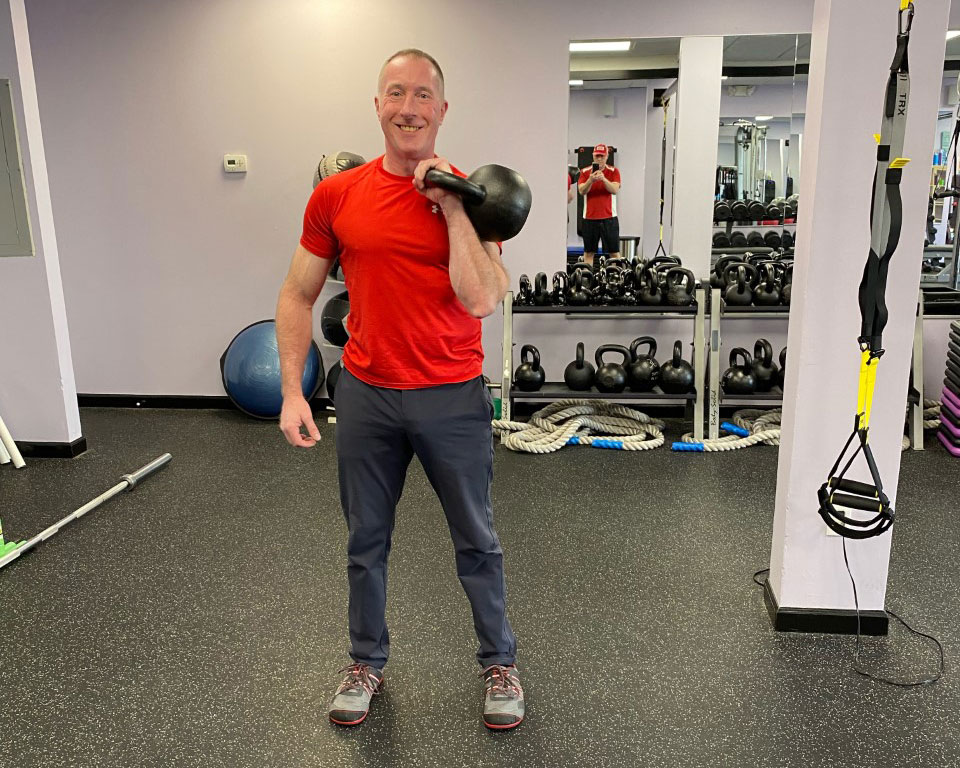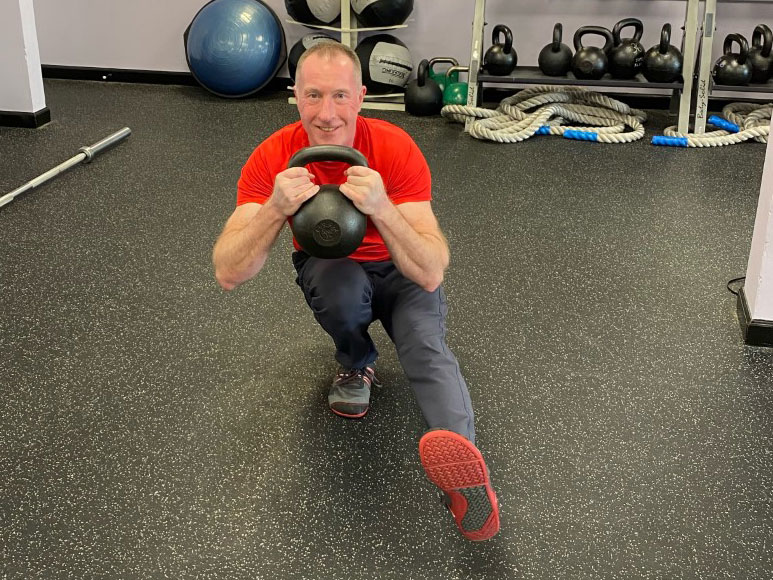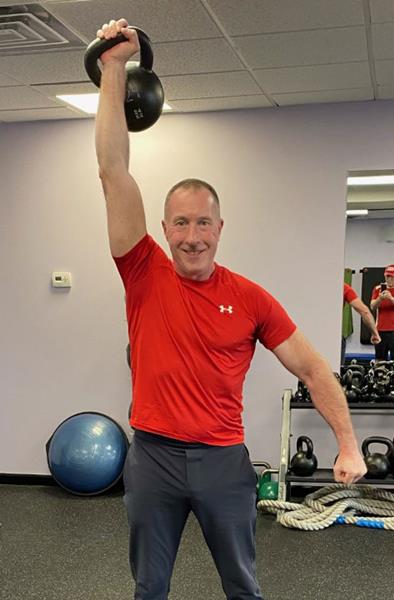The Hidden Benefits of Kettlebell Training. Interview with Brian McMaster, RKC Team Leader
By Adrienne Harvey, Senior RKC, Senior PCC

Adrienne Harvey: Congratulations on your promotion to RKC Team Leader, it looks like you've enjoyed a long career in fitness. How did you first become interested in personal training?
Brian McMaster: It was a change of career for me after college. I went into vocational rehabilitation and working in mental health--which I loved because I love helping people. But to make any money in that field, you had to progress into higher positions where you're no longer working with people. I had started by working with people, then I was working with people who work with people, then I became the director of an agency. At that point I was just on the phone with insurance companies or trying to get funds from the state. It was not an enjoyable job. One of the highlights of my day was going down to our drop-in center at lunch and working out with whoever wanted to work out with me.
Eventually I decided to change careers, and considered pursuing fitness. So, I went back to school and
became a trainer in 2003. I started in Colorado and then moved to the east coast with the intention of opening a gym with my brother—in a town that didn't have a gym. Unfortunately, we found out why: the woman who runs the health department banned gyms because she thought they would use too much water—and the whole town was on a well.
Gyms from around the country sent their water bills to us, and the landlord helped us fight with her for about a year, but she still was not going to let it happen. Since I still needed to work, I kept training in two different towns before eventually opening Inspire Fitness in Stamford, Connecticut.
Adrienne Harvey: How did you become interested in kettlebells?
Brian McMaster: In either 2009 or 2010, I was working at a facility and a guy came who wanted to move or change careers came in with a set of
kettlebells: 16kg, 24kg, and 32kg he wanted to sell to our gym. So, we convinced the gym owner to buy them. Another trainer and I started to get creative with them—though we hadn't thought to look on the internet just yet. We had fun, but at first it was just us trying to decipher what to do with them, we weren't even using them with clients yet.
Then, we looked online and on YouTube and found
Pavel, and that's when we started to really see how we could introduce kettlebells to our clientele. What really drew me in was that whether we were training a young athlete or someone in their seventies or eighties we saw great improvements. We might be using different exercises—someone may just be doing deadlifts instead of versus swings—but they were still seeing great improvements.
I continued to pursue learning more about kettlebells and eventually decided to become a certified instructor in 2011! I recertified in 2015 with
Dan John, Coach Fury and Annie Vo in New York. It was this great zero-ego approach, you could tell they just wanted to help you get better. This was revelatory to me and I loved how I could take all of it back to my clients. And it was a real community at that 2015
RKC certification—everyone was encouraged to read their manual, but we also all went out and got a beer together—it was great!

I have subsequently found that deep sense of community at my
RKC 2 and at each certification I have assisted at after that one in 2015. I had a great conversation with Dan John about how important it is to make time to create community at the certifications.
Adrienne Harvey: When did you open your gym and did kettlebells feature in your training?
Brian McMaster: Absolutely. In 2012, the gym where I was working (when the guy came in and sold the kettlebells) moved across town. It may have not seemed like a big deal, but for a lot of the clients, their five-minute trip to the gym became a half hour drive. Which meant their training session would now take two hours out of their day--and this was pre-pandemic so they were not working from home. When the gym moved, my clients urged me to open a space. So a partner and opened a gym and we've been running it for 10 years in Stamford. I look forward to continuing Inspire Fitness as it moves to New Canaan, Connecticut.
Adrienne Harvey: Excellent! How are you using kettlebells with your clients?
Brian McMaster: They're part of a larger toolkit. But, I would say I use kettlebells with everybody in some way along with some type of
mobility training. Kettlebells have been really great tools for all my clients. One client in particular was reticent to try training because of a past back injury. So, she had avoided exercise for many years. We started slowly, but now she loves that kettlebells have strengthened her back. She often tells me the only thing she's done longer than train with me is nothing—and she did nothing for years. Now she's no longer afraid of picking up the laundry or doing other everyday tasks.
And believe it or not, a kettlebell actually helped one of my clients achieve her goal of getting a pull-up. She already had the upper body strength but was hanging limp like a rag otherwise. The
kettlebell swing got her to feel the right kind of tension--and how to create it. Now she can do
10 pull-ups and has become a personal trainer!
Adrienne Harvey: That's a perfect example of a hidden benefit of kettlebell training--it can help people use the strength they already have--and help them get stronger. How are you using kettlebells in your own training?
Brian McMaster: I used to do a decent amount of running, but had stopped. Then a couple of clients talked me into doing Spartan Races with them. Even though all I'd been doing was
kettlebell training, it was like I had never stopped running! I have been more worried about the running and not the obstacles in the races. But, the kettlebells seemed to prepare me very well!
Adrienne Harvey: That's excellent! You were recently promoted to RKC Team Leader, any plans for your new role and your gym?
Brian McMaster: I'd like to host an
HKC this year, and I will hopefully be able to recruit other trainer friends who own gyms to attend. Currently, we have in-person classes, but are still leading virtual sessions. The virtual sessions along with the kettlebells are what saved our gym.
When we were forced to shut down, we loaned out our
equipment to our clients. Then we did Zoom or FaceTime sessions--whichever the client was most comfortable with. Being able to give people kettlebells that they were already well-versed in using, let us continue our training sessions uninterrupted. On day one, 95% of our clients switched to virtual training, and a few more who started back a month later. When we were allowed to reopen in August, everyone was still in great shape because we were all able to keep training virtually!
Adrienne Harvey: Do you have an online training tip or two for leading strong kettlebell virtual sessions?
Brian McMaster: The biggest tip I have is to not be shy about asking people to change angles so that I can properly see their technique properly. Since I can't move around them like we do when training someone in person. So, requesting that they move in their space so that you can see what they're doing and help them the most.

Adrienne Harvey: Were you leading group training or personal training sessions?
Brian McMaster: Both one-on-one and group training. One of our groups has remained virtual the whole time, and a few who moved to other parts of the country are still showing up to train online. I met with them this morning--someone from North Carolina, another from New York, and a client in Connecticut. They've loved staying in touch with each other as well as training together. Couple of the people moved away to other parts of the country. So we still, I met with them this morning. So that was fun.
Adrienne Harvey: That's really cool. So, since opening back up last August, you've been continuing a hybrid model?
Brian McMaster: By now almost everyone is back to training in person, but we have a handful of people who have not come back--mainly because they're afraid of Covid, but other folks have found it's just much easier to roll out of bed and train at home rather than drive to the gym.
Adrienne Harvey: It's good to that you're able to offer both!
Brian McMaster: My overall philosophy for training has stayed the same as it was when I first started in previous career: I want to do everything I can to help people succeed. With training, it's been the same thing. People come to our gym and we meet them where they're at so we can help them meet the goals they want to meet, or achieve what they wish to achieve.
Brian McMaster: One of our new clients just started two weeks ago with the goal of being in shape for her son's Bar Mitzvah. Even though we only have a few weeks, we're going to do the best we can. Again, we want to help people with what they want to achieve, while providing them with the training they need--strength, mobility, whatever they may need.
Kettlebells have been great for that. Once people overcome their initial fear of using a kettlebell, it's a great tool to help them get stronger, and also move better.
Back